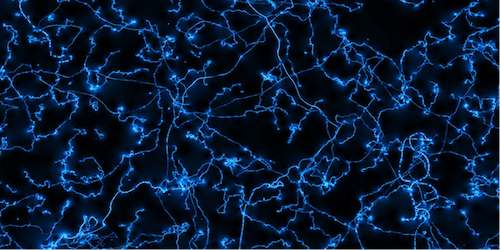Cosmic Strings’ Imprints in High-Frequency Gravitational Waves
Existing and planned gravitational-wave detectors, from pulsar timing arrays to laser interferometers, probe signal frequencies up to several kilohertz. But higher frequencies offer a detection window clean of astrophysical signals (such as those from black hole binaries) and dominated by signals coming from early-Universe processes (inflation, primordial phase transitions, and more). Now Géraldine Servant of Hamburg University, Germany, and the German Electron Synchrotron DESY and Peera Simakachorn of the University of Valencia, Spain, compute the spectrum of one possible source of primordial signals—cosmic strings [1]. The results suggest that cosmic strings might be the dominant source of ultrahigh-frequency signals.
Cosmic strings are almost-one-dimensional, topological spacetime defects that, like cracks in ice, may form during a symmetry-breaking phase transition. Such strings may form loops that decay by releasing gravitational waves. Servant says the search for these waves is well motivated, as cosmic strings emerge in most theories that go beyond the standard model of particle physics. The duo considers two scenarios where strings result from “local” and “global” symmetry breaking and compute their respective emissions. The researchers conclude that local strings could generate most of the high-frequency emission allowed by existing observational constraints, dwarfing the signal from “global” strings associated with models that involve hypothetical “heavy-axion” particles.
If detectors ever reach the sensitivity needed to spot these signals, slopes and kinks in the signal spectrum would carry information on the fields that produced the strings, potentially holding the key to developing grand unified theories. However, the new calculations show that none of the so-far-theorized detector concepts [2] offers serious detection potential, says Simakachorn. Servant adds, “It’s clear that we’d need a kind of revolution in detection techniques, but the scientific case for primordial signals is very strong.”
–Matteo Rini
Matteo Rini is the Editor of Physics Magazine.
References
- G. Servant and P. Simakachorn, “Ultrahigh frequency primordial gravitational waves beyond the kHz: The case of cosmic strings,” Phys. Rev. D 109, 103538 (2024).
- N. Aggarwal et al., “Challenges and opportunities of gravitational-wave searches at MHz to GHz frequencies,” Living Rev. Relativ. 24, 4 (2021).




